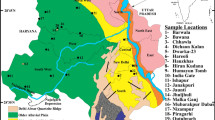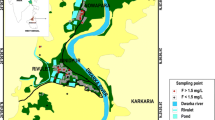Abstract
The processes that control halide concentrations in coastal aquifers of the Thriassion Plain in Greece include both natural and anthropogenic factors as follows: evapotranspiration, dissolution of evaporites, domestic sewage as well as dissolution of minerals containing fluoride. Groundwater monitoring data indicate that the Cl−/Br− mass ratio ranges between 43 and 1510. Ratios ranging round the value 292 are attributed to sea intrusion; 300–600 to domestic sewage; and 900–1510 to dissolution of evaporites. The evaporation of irrigated water plays an important role as well. Fluoride concentrations ranging from 0.1 up to 9.94 mg/l possibly originate from Holocene as well as Plio–Pleistocene sediments which contain organic material. It is also likely that fluoride originates from fluorite dissolution or comes from Palaeozoic-Middle Triassic volcano-sedimentary rocks which occur around the wider area and constitute the basement of the study area. In those rocks, the alteration of biotite to chlorite takes place under the influence of hydrothermal fluids, as the Thriassion Plain is close to South Aegean volcanic arc where volcanic activity exists.










Similar content being viewed by others
References
Andreasen D, Fleck W (1997) Use of bromide: chloride ratios to differentiate potential sources of chloride in a shallow unconfined aquifer affected by brackish-water intrusion. Hydrogeol J 5(2):17–26
Appelo CAJ, Postma D (1993) Geochemistry, groundwater and pollution. Balkema, Rotterdam, p 536
Behl E (1990) Chloride/bromide ratios as a natural tracer of urban runoff in the Tucson basin, Arizona. M.S. thesis, Department of Hydrology and Water Resources, University of Arizona, Tucson, Arizona
Behne W (1953) Untersuchungen zur Geochemie des Chlor und Brom. Geochim Cosmochim Acta 3(4):186–214
Bell ME, Largent EJ, Ludwig TG, Muhler JC, Stookey GK (1970) The supply of fluorine to man. In: Fluorides and human health. Geneva, World Health Organization, pp 17–74 (WHO Monograph Series No. 59)
Bloch MR, Schnerb J (1954) On the Cl−/Br− ratio and the distribution of Br− ions in liquids and solids during evaporation of bromide-containing chloride solutions. Bull Res Counc Isr 3:151–158
Bloch MR, Kaplan D, Kertes V, Schnerb J (1966) Ion separation in bursting air bubbles: an explanation for the irregular ion ratios in atmospheric precipitation. Nature 209(5025):802–803
Boggs M, Adams EE (1992) Field study of dispersion in a heterogeneous aquifer4: investigation of adsorption and sampling bias. Water Resour Res 28(12):3325–3328
Bower CA, Hatcher JT (1967) Adsorption of fluoride by soils and minerals. Soil Sci 103(3):151–154
Chidambaram S, Bala Krishna Prasad M, Manivannan R et al (2012) Environmental hydrogeochemistry and genesis of fluoride in groundwaters of Dindigul district, Tamilnadu (India). Environ Earth Sci 68:333–342
Christides A, Mavrakis A, Sigalos G, Loukaidi V, Dasaklis S, Mitilineou A, Mourikis D, Makrygiannis G (2009) Assessing saltwater front parameters of the aquifer of the Thriassion Plain, Greece. In: 11th International conference on environmental science and technology (11th ICEST), vol B. Chania Crete, pp 171–178
Cloutier V, Lefebvre R, Savard MM et al (2010) Desalination of a sedimentary rock aquifer system invaded by Pleistocene Champlain sea water and processes controlling groundwater geochemistry. Environ Earth Sci 59:977. doi:10.1007/s12665-009-0091-8
Davis SN, Whittemore DO, Fabryka-Martin J (1998) Uses of chloride/bromide ratios in studies of potable water. Ground Water 36:338–350
Dimitriou E, Mentzafou A et al. (2011) Monitoring of the ecological quality of Koumoundourou Lake and designing of management, restoration and development actions. 2nd Technical report, IIW-HCMR
Dounas A (1971) The geology between Megara and Erithres area, PhD University of Athens
Dounas Α, Panagiotides G (1964) Precursor report on the hydrogeological conditions of Thriassion Institute of Geology and Subsurface Research, Athens
Duce R, Winchester JW, Van Nahl TW (1965) Iodine, bromine and chloride in the Hawaiian marine atmosphere Jour. Geophys Res 70:1775–1799
Edmunds WM, Smedley PL (2013) Fluoride in natural waters. In: Selinus O (ed) Essentials of medical geology, Springer, Netherlands, pp 311–336
Fabryka-Martin JT, Whittemore DO, Davis SN, Kubic PW, Sarma P (1991) Geochemistry of halogens in the Milk River aquifer, Alberta, Canada. Appl Geochem 6(4):447–464
Fuge R (1969) Bromine. In: Wedepohl KH (ed) Handbook of geochemistry, vol 2. Springer, Berlin, pp 35-B1–35-16
Goumas G (2006) Investigation of the structure of Thriassion Plain based on geophysics. MSc thesis, University of Athens
Haidouti C (1991) Fluoride distribution in soils in the vicinity of a point emission source in Greece. Geoderma 49(1):129–138
Hem JD (1985) Study and interpretation of the chemical characteristics of natural waters, 3rd edn. U.S. Geological Survey Water-Supply Paper 2254
Hermides D, Mimides Th, Stamatis G (2016) Contribution to hydraulic characteristics of Plio–Pleistocene deposits of Thriassion Plain of Attica. In: Bulletin of the geological society of Greece, vol L, 2016, 14th International conference, Thessaloniki, May 2016
Hogan JF, Phillips FM, Mills SK, Hendrickx JMH, Ruiz J, Chesle JT, Asmerom Y (2007) Geologic origins of salinization in a semi-arid river: the role of sedimentary basin brines. Geology 35(12):1063–1066
Iliopoulos G, Stamatis G, Stournaras G (2010) Marine and human activity effects on the groundwater quality of Thriassion Plain, Attica, Greece. In: Proceedings of the 9th International Hydrogeological Congress of Greece, 2, 409–416, doi:10.1007/978-3-642-24076-8, Kalavrita, 5–8 October 2011 Lambrakis N et al. (eds), Advances in the research of aquatic environment, Springer, Berlin, Heidelberg, 2011
Kallieris D (2010) Our village, vol 2. Cultural Center, Aspropyrgos, p 586
Kambouroglou E (1989) Eretria paleogeographic and geomorphological evolution during Holocene relationship of the natural environment and ancient settlements. PhD thesis, UNKA
Kaminari MA (1994) Geochemical pilot survey of the lands of the wider region of Eleusis (Thriassion Plain) to detect pollution from heavy metals IGME, Athens
Karambela A (1997) Geomorphological and environmental study of Thriassion Plain. PhD, Faculty of Geology and Geoenvironment, NKUA
Katsikatsos G, Mettos A, Vidakis M, Dounas A, Pomoni F, Tsaila-Monopolis S, Skourtsi-Koroneou V (1986) Geological map of Greece, in scale 1:50.000, “Athina-Elefsis” sheet, IGME publication, Athens
Kilham P, Hecky RE (1973) Fluoride: geochemical and ecological significance in East African waters and sediments. Limnol Oceanogr 18:932–945
Kounis G, Siemos N, (1991) Spot hydrogeological survey of Thriassion Plain aquifers for the water supply needs of the Greek Aspropyrgos Refinery IGME, Athens
Kraft J, Kayan I, Erol O (1980) Geomorphic reconstructions in the environs of ancient troy. Science 209(4458):776–782
Lambeck K (1996) Sea Level change and shore-line evolution in Aegean Greece since Upper Palaeolithic time. Antiquity 70(269):588–611
Lioni A, Stournaras G, Stamatis G (2008) Degradation of groundwater quality of Thriassion Plain through natural factors and human activity. In: Proceedings of the 8th Hydrogeological Congress of Greece, vol 2, p 577
Lionis M (1992) Hydrogeological study of Poikilon Mt., ASDA, Athens
Liu H, Guo H, Yang L et al (2015) Occurrence and formation of high fluoride groundwater in the Hengshui area of the North China Plain. Environ Earth Sci 74:2329–2340
Lloyd JW, Heathcote JA (1985) Natural inorganic hydrochemistry in relation to groundwater. Clarendon press, Oxford
Luong TV, Peters CJ, Perry R (1983) Occurrence of bromide in source and treated waters. Effluent Water Treat J 23(5):192–197
Magganas A, Kyriakopoulos K (2005) Meta-pyroclastic and meta-volcanic rocks of Mid-Triassic Age in western Attica. In: 2nd Congress of commission of Economic Geology, Mineralogy and Geochemistry, Thessaloniki 2005, pp 189–198
Makarona A (2012) Complexation of copper in atmospheric precipitation in coastal areas, MSc thesis, University of Athens
Makri P (2008) Investigating the pollution from BTEX in the groundwater of Thriassion Plain, Ph.D. University of Athens
Mariolakos I, Fountoulis I, Sideris C, Chatoupis T (2001) Morphoneotectonic structure of Parnes’ Mt of Attica. In: Proceedings of the 9th International Congress, Athens, bulletin of the geological society of Greece, vol 24, no 1, pp 183–190
McCaffrey MA, Lazar B, Holland HD (1987) The evaporation path of seawater and the coprecipitation of Br− and K+ with halite. J Sediment Petrol 57(5):928–937
Mimides Th (2005) Groundwater hydrochemistry and microbiology. Agricultural University of Athens, Athens
Mimides Th (2002) Pollution source and suggestions on environmental upgrading of Lake Koumoundourou. Environmental impact study, Agricultural University for the Prefecture of Western Attica
Mondal D, Gupta S (2014) Fluoride hydrogeochemistry in alluvial aquifer: an implication to chemical weathering and ion-exchange phenomena Environ. Earth Sci 73:3537–3554
Mountrakis D (1986) The Pelagonian zone in Greece: a polyphase-deformed fragment of the Cimmerian continent and its role in the geotectonic evolution of the eastern Mediterranean. J Geol 94:335–347
Mun AE, Bazilevicxi ZA, Budeyeva KI (1966) Geochemical behavior of fluoride in the bottom sediments of continental basins. Geochim Int 3:698–703
Nanyaro JT, Aswathanarayana U, Mungure JS (1984) A geochemical model for the abnormal fluoride concentrations in waters in parts of northern Tanzania. J Afr Earth Sci 2:129–140
Nassery HR, Kayhomayoon Z (2012) Source of salinity in the groundwater of Lenjanat Plain, Isfahan, Iran. Environ Earth Sci 68:413–427
Papanikolaou D, Lekkas E, Sideris Ch, Fountoulis I, Danamos G, Kranis CH, Lozios L (1999) Geology and tectonics of Western Attica in relation to the 7-9-99 earthquake. Newsletter of E.C.P.F.E., Council of Europe, 3: 30–34
Paraschoudes Β (2002) Hydrogeological study of western Attica. Agricultural Ministry of Greece, Athens
Parkhurst DL, Appelo CAJ (2013) Description of input and examples for PHREEQC version 3—a computer program for speciation, batch-reaction, one-dimensional transport, and inverse geochemical calculations, techniques and methods 6-A43. U.S. Geological survey, Denver, Colorado
Phillips FM, Hogan J, Mills S, Hendricks MH (2001) Environmental tracers applied to quantifying causes of salinity in arid-region rivers: preliminary results from the Rio Grande, southwestern USA. In: Alsharhan AS, Wood WW (eds) Water resources perspectives: evaluation, management, and policy: developments in water science, vol 50. Elsevier Science, Amsterdam, pp 327–334
Price D, Iddon B, Wakefield BJ (1988) Bromine Compounds: Chemistry and Applications. Elsevier, Amsterdam
Rittenhouse G (1967) Bromine in oil-field waters and its use in determining possibilities of origin of these waters. Am Assos Pet Geol Bull 51(12):2430–2440
Saxena VK, Ahmed S (2003) Inferring the chemical parameters for the dissolution of fluoride in groundwater. Environ Geol 43:731–736
Skianis G, Noutsis B (2008) Geophysics study in Thriassion Plain. IGME, Athens
Vengosh A, Pankratov I (1998) Chloride/bromide and chloride/fluoride ratios of domestic sewage effluents and associated contaminated ground water. Ground Water 36:815–824
Wang W, Li R, Tan JA, Luo K, Yang L, Li H, Li Y (2002) Adsorption and leaching of fluoride in soils of China. Fluoride 35(2):122–129
Whittemore DO (1995) Geochemical differentiation of oil and gas brine from other saltwater sources contaminating water resources; case studies from Kansas and Oklahoma. Environ Geosci 2(1):15–31
Wilson TP, Cabet RM (1991) Bromide uptake by soils and shales EOS. Am Geophys Union Trans 72(44):177
Windom HL (1971) Fluoride concentration in coastal and estuarine waters of Georgia. Limnol Oceanogr 16:806–810
WHO (2002) Fluorides. World Health Organization. Geneva (Environmental Health Criteria 227)
Zacharias A, Sarandakos Κ, Andre C, (2003) Report on sample drilling and morphotectonics study in the area around Koumoundourou Lake, 2nd technical report, ELKETHE/IIW
Zvorykin I (1948) Contribution to the question of secondary salinity of the soils of Attica, vol 23. Academy of Athens, Athens, pp 436–448
Acknowledgements
This study is part of a doctoral thesis which is in progress at the expenses of the Agricultural University of Athens. The author is thankful to Prof. Stamatis G. of Agricultural University of Athens and Prof. Mimides Th. for their valuable help.
Author information
Authors and Affiliations
Corresponding author
Rights and permissions
About this article
Cite this article
Hermides, D., Stamatis, G. Origin of halogens and their use as environmental tracers in aquifers of Thriassion Plain, Attica, Greece. Environ Earth Sci 76, 306 (2017). https://doi.org/10.1007/s12665-017-6611-z
Received:
Accepted:
Published:
DOI: https://doi.org/10.1007/s12665-017-6611-z




